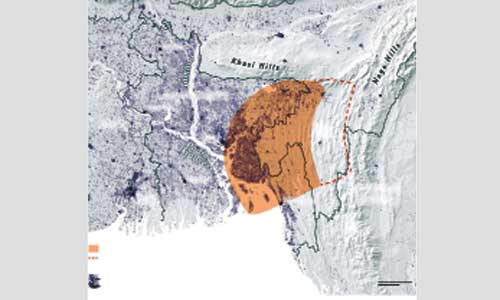Bangladesh risks megaquake
A massive hidden fault, discovered recently, could trigger a cataclysmic quake beneath Bangladesh, and parts of India and Myanmar, revealed a new research.
The hidden fault, buried deep under river sediments, could cause the devastating quake of 8.2 to 9 magnitude, show the recent findings.
The quake could cause devastations in the capital of Bangladesh and its eastern region as well as parts of Myanmar and Eastern India, show the findings.
As the fault was discovered by researchers recently, they could not predict when the quake would strike.
Co-researcher Syed Humayun Akhter, who teaches geology at Dhaka University, told New Age, ‘We discovered the hidden fault during an 11-year study spanning 2003 to 2014.’
He said ultrasensitive GPS devices were used for the study.
Humayun said, ‘hypothetically we cautioned for long that a mega quake could strike the Bangladesh capital.’
‘Now we can say specifically that the mega quake would strike,’ he said.
Humayun said that the hidden fault could trigger the mega quake causing devastations in the capital and the eastern region of Bangladesh.
The existence of gas fields, power plants, heavy industries and utility supply lines in the areas in Bangladesh could cause greater devastations, said professor Humayun.
He said that the devastations could even force the nation to abandon its historic capital.
Findings of the study titled, ‘Locked and loading megathrust linked to active subduction beneath the Indo-Burman Ranges’ was published by Nature Geoscience in the July 11 issue of the journal.
The research was jointly conducted by Michael S. Steckler, geophysicist at the Lamont-Doherty Earth Observatory at Columbia University in New York City, along with Dhiman Ranjan Mondal, Syed Humayun Akhter, Leonardo Seeber, Lujia Feng, Jonathan Gale, Emma M. Hill and Michael Howe.
They said that 140 million people in the three countries including 17 million of the Bangladesh capital live within 100 km of the fault.
‘We don’t know if it’s tomorrow or if it’s not going to be for another 500 years,’ said study co author Michael Steckler.
Bangladesh, he said, already faces problems with poor construction.
‘I’ve seen them pumping sand to build up the ground level to build a 20-story building,’ he told Live Science.
‘If there’s an earthquake that ground is going to liquefy and the building is just going to fall over,’ he said.
Not only would the Bangladesh capital be incredibly vulnerable to widespread building collapse, but overcrowding could make it difficult to rescue people who survive the initial quake, Steckler said.
‘Right now, the streets of the Bangladesh capital are clogged with traffic for which it’s impossible to drive around even on a normal day,’ Steckler said.
‘If you fill the streets with debris, it’s really going to be impossible to get supplies and rescue equipment and things like that around,’ he said.
The GPS network installed by the researchers for the study revealed that one plate is diving under the other deep beneath the surface in an area encompassing Bangladesh and parts of Myanmar and eastern India.
At the upper layers of the fault, the two plates are stuck together, building up strain that could produce a megathrust earthquake if it ruptures, said the researchers.
Based on the strain data, the researchers estimated that the fault could unleash a quake with 8.2 to 9 magnitude.
News Courtesy: www.newagebd.net











